The Effect of Non-Uniform Magnetic Field on the Efficiency of Mixing in Droplet-Based Microfluidics: A Numerical Investigation
Abstract
1. Introduction
2. Materials and Methods
2.1. General Overview of the Model
2.2. Material Parameters and Geometry
2.3. Governing Equations
2.3.1. Droplet Formation
2.3.2. Mixing Process
2.3.3. Calculation of the Magnetic Force
2.4. Numerical Simulation
2.5. Droplet Model
2.6. Boundary Conditions
3. Results and Discussion
3.1. Validation
3.2. Droplet Generation
3.3. Mixing Inside Droplets
3.3.1. Mixing with Changing the Direction of the Magnet
3.3.2. Mixing Efficiency with Different Concentrations of Ferrofluids and Magnetic Field Intensities
3.3.3. Active and Passive Mixers
3.3.4. Comparison between Passive and Active Methods
4. Conclusions
Author Contributions
Funding
Conflicts of Interest
References
- Teh, S.-Y.; Lin, R.; Lee, A.P.; Hung, L.-H.; Lee, A.P. Droplet microfluidics. Lab Chip 2008, 8, 2198–2220. [Google Scholar] [CrossRef] [PubMed]
- Nasiri, R.; Shamloo, A.; Akbari, J. Design of a Hybrid Inertial and Magnetophoretic Microfluidic Device for CTCs Separation from Blood. Micromachines 2021, 12, 877. [Google Scholar] [CrossRef] [PubMed]
- Maleki, S.; Shamloo, A.; Kalantarnia, F. Tubular TPU/SF nanofibers covered with chitosan-based hydrogels as small-diameter vascular grafts with enhanced mechanical properties. Sci. Rep. 2022, 12, 6179. [Google Scholar] [CrossRef] [PubMed]
- Sesen, M.; Alan, T.; Neild, A. Microfluidic plug steering using surface acoustic waves. Lab a Chip 2015, 15, 3030–3038. [Google Scholar] [CrossRef]
- Shamloo, A.; Naghdloo, A.; Besanjideh, M. Cancer cell enrichment on a centrifugal microfluidic platform using hydrodynamic and magnetophoretic techniques. Sci. Rep. 2021, 11, 1939. [Google Scholar] [CrossRef]
- Mashhadian, A.; Shamloo, A. Inertial microfluidics: A method for fast prediction of focusing pattern of particles in the cross section of the channel. Anal. Chim. Acta 2019, 1083, 137–149. [Google Scholar] [CrossRef]
- Handique, K.; Burns, M.A. Mathematical modeling of drop mixing in a slit-type microchannel. J. Micromech. Microeng. 2001, 11, 548–554. [Google Scholar] [CrossRef]
- Nasiri, R.; Shamloo, A.; Akbari, J.; Tebon, P.; Dokmeci, M.R.; Ahadian, S. Design and Simulation of an Integrated Centrifugal Microfluidic Device for CTCs Separation and Cell Lysis. Micromachines 2020, 11, 699. [Google Scholar] [CrossRef]
- Amadeh, A.; Ghazimirsaeed, E.; Shamloo, A.; Dizani, M. Improving the performance of a photonic PCR system using TiO2 nanoparticles. J. Ind. Eng. Chem. 2021, 94, 195–204. [Google Scholar] [CrossRef]
- Asadzade, M.; Shamloo, A. Design and simulation of a novel bipolar plate based on lung-shaped bio-inspired flow pattern for PEM fuel cell. Int. J. Energy Res. 2017, 41, 1730–1739. [Google Scholar] [CrossRef]
- Shamloo, A.; Mashhadian, A. Inertial particle focusing in serpentine channels on a centrifugal platform. Phys. Fluids 2018, 30, 012002. [Google Scholar] [CrossRef]
- Shamloo, A.; Kamali, A. Numerical analysis of a dielectrophoresis field-flow fractionation device for the separation of multiple cell types. J. Sep. Sci. 2017, 40, 4067–4075. [Google Scholar] [CrossRef]
- Shamloo, A.; Selahi, A.; Madadelahi, M. Designing and modeling a centrifugal microfluidic device to separate target blood cells. J. Micromech. Microeng. 2016, 26, 035017. [Google Scholar] [CrossRef]
- Bui, T.Q.; Ton, S.N.; Duong, A.T.; Tran, H.T. Dependence of magnetic responsiveness on particle size of magnetite nanoparticles synthesised by co-precipitation method and solvothermal method. J. Sci. Adv. Mater. Devices 2018, 3, 107–112. [Google Scholar] [CrossRef]
- Madadelahi, M.; Shamloo, A. Droplet-based flows in serpentine microchannels: Chemical reactions and secondary flows. Int. J. Multiph. Flow 2017, 97, 186–196. [Google Scholar] [CrossRef]
- Naghdloo, A.; Ghazimirsaeed, E.; Shamloo, A. Numerical simulation of mixing and heat transfer in an integrated centrifugal microfluidic system for nested-PCR amplification and gene detection. Sens. Actuators B Chem. 2019, 283, 831–841. [Google Scholar] [CrossRef]
- Shamloo, A.; Vatankhah, P.; Akbari, A. Analyzing mixing quality in a curved centrifugal micromixer through numerical simulation. Chem. Eng. Process. Process Intensif. 2017, 116, 9–16. [Google Scholar] [CrossRef]
- Besanjideh, M.; Shamloo, A.; Hannani, S.K. Enhanced oil-in-water droplet generation in a T-junction microchannel using water-based nanofluids with shear-thinning behavior: A numerical study. Phys. Fluids 2021, 33, 012007. [Google Scholar] [CrossRef]
- Ahrberg, C.D.; Manz, A.; Chung, B.G. Polymerase chain reaction in microfluidic devices. Lab Chip 2016, 16, 3866–3884. [Google Scholar] [CrossRef]
- Chen, C.-Y.; Lin, C.-Y.; Hu, Y.-T.; Cheng, L.-Y.; Hsu, C.-C. Efficient micromixing through artificial cilia actuation with fish-schooling configuration. Chem. Eng. J. 2015, 259, 391–396. [Google Scholar] [CrossRef]
- Yang, L.; Li, S.; Liu, J.; Cheng, J.; Liua, J. Fluid mixing in droplet-based microfluidics with T junction and convergent-divergent sinusoidal microchannels. Electrophoresis 2018, 39, 512–520. [Google Scholar] [CrossRef] [PubMed]
- Kashid, M.N.; Gerlach, I.; Goetz, S.; Franzke, J.; Acker, J.F.; Platte, F.; Agar, A.D.W.; Turek, S. Internal Circulation within the Liquid Slugs of a Liquid−Liquid Slug-Flow Capillary Microreactor. Ind. Eng. Chem. Res. 2005, 44, 5003–5010. [Google Scholar] [CrossRef]
- Chandorkar, A.; Palit, S. Simulation of droplet dynamics and mixing in microfluidic devices using a VOF-based method. Sens. Transducers 2009, 7, 136. [Google Scholar]
- Muradoglu, M.; Stone, H.A. Mixing in a drop moving through a serpentine channel: A computational study. Phys. Fluids 2005, 17, 073305. [Google Scholar] [CrossRef]
- Yao, C.; Zhao, Y.; Ma, H.; Liu, Y.; Zhao, Q.; Chen, G. Two-phase flow and mass transfer in microchannels: A review from local mechanism to global models. Chem. Eng. Sci. 2021, 229, 116017. [Google Scholar] [CrossRef]
- Yu, Q.; Chen, X.; Li, X.; Zhang, D. Optimized design of droplet micro-mixer with sinusoidal structure based on Pareto genetic algorithm. Int. Commun. Heat Mass Transf. 2022, 135, 106124. [Google Scholar] [CrossRef]
- Roy, T.; Sinha, A.; Chakraborty, S.; Ganguly, R.; Puri, I.K. Magnetic microsphere-based mixers for microdroplets. Phys. Fluids 2009, 21, 027101. [Google Scholar] [CrossRef]
- Bijarchi, M.A.; Yaghoobi, M.; Favakeh, A.; Shafii, M.B. On-demand ferrofluid droplet formation with non-linear magnetic permeability in the presence of high non-uniform magnetic fields. Sci. Rep. 2022, 12, 1–23. [Google Scholar] [CrossRef]
- Zhang, Y.; Wang, T.-H. Full-Range Magnetic Manipulation of Droplets via Surface Energy Traps Enables Complex Bioassays. Adv. Mater. 2013, 25, 2903–2908. [Google Scholar] [CrossRef]
- Rezaeian, M.; Afjoul, H.; Shamloo, A.; Maleki, A.; Afjoul, N. Green synthesis of silica nanoparticles from olive residue and investigation of their anticancer potential. Nanomedicine 2021, 16, 1581–1593. [Google Scholar] [CrossRef]
- Chong, W.H.; Huang, Y.; Wong, T.N.; Ooi, K.T.; Zhu, G.-P. Magnetic Nanorobots, Generating Vortexes Inside Nanoliter Droplets for Effective Mixing. Adv. Mater. Technol. 2018, 3, 1700312. [Google Scholar] [CrossRef]
- Maleki, M.A.; Soltani, M.; Kashaninejad, N.; Nguyen, N.-T. Effects of magnetic nanoparticles on mixing in droplet-based microfluidics. Phys. Fluids 2019, 31, 032001. [Google Scholar] [CrossRef]
- Zhu, G.-P.; Nguyen, N.-T.; Ramanujan, R.V.; Huang, X.-Y. Nonlinear Deformation of a Ferrofluid Droplet in a Uniform Magnetic Field. Langmuir 2011, 27, 14834–14841. [Google Scholar] [CrossRef] [PubMed]
- Varma, V.; Ray, A.; Wang, Z.M.; Ramanujan, R.V. Droplet Merging on a Lab-on-a-Chip Platform by Uniform Magnetic Fields. Sci. Rep. 2016, 6, 37671. [Google Scholar] [CrossRef] [PubMed]
- Besanjideh, M.; Rezaeian, M.; Mahmoudi, Z.; Shamloo, A.; Hannani, S.K. Investigating the effects of precursor concentration and gelling parameters on droplet-based generation of Ca-Alginate microgels: Identifying new stable modes of droplet formation. Mater. Today Chem. 2022, 24, 100821. [Google Scholar] [CrossRef]
- Olsson, E.; Kreiss, G. A conservative level set method for two phase flow. J. Comput. Phys. 2005, 210, 225–246. [Google Scholar] [CrossRef]
- Kenig, E.Y.; Ganguli, A.A.; Atmakidis, T.; Chasanis, P. Chemical Engineering and Processing: Process Intensification A novel method to capture mass transfer phenomena at free fluid—Fluid interfaces. Chem. Eng. Process. Process Intensif. 2011, 50, 68–76. [Google Scholar] [CrossRef]
- De Regt, J.M.; Van Dijk, J.; Van Der Mullen, J.A.M.; Schram, D.C. Components of continuum radiation in an inductively coupled plasma. J. Phys. D. Appl. Phys. 1995, 28, 40–46. [Google Scholar] [CrossRef][Green Version]
- Lavrova, O.; Matthies, G.; Mitkova, T.; Polevikov, V.; Tobiska, L. Numerical treatment of free surface problems in ferrohydrodynamics. J. Physics Condens. Matter 2006, 18, S2657–S2669. [Google Scholar] [CrossRef]
- Shamloo, A.; Hassani-Gangaraj, M. Investigating the effect of reagent parameters on the efficiency of cell lysis within droplets. Phys. Fluids 2020, 32, 062002. [Google Scholar] [CrossRef]
- Bai, L.; Fu, Y.; Yao, M.; Cheng, Y. Enhancement of mixing inside ionic liquid droplets through various micro-channels design. Chem. Eng. J. 2018, 332, 537–547. [Google Scholar] [CrossRef]
- Belousov, K.I.; Filatov, N.A.; Kukhtevich, I.V.; Kantsler, V.; Evstrapov, A.A.; Bukatin, A.S. An asymmetric flow-focusing droplet generator promotes rapid mixing of reagents. Sci. Rep. 2021, 11, 8797. [Google Scholar] [CrossRef] [PubMed]
- Shyam, S.; Mondal, P.K.; Mehta, B. Magnetofluidic mixing of a ferrofluid droplet under the influence of a time-dependent external field. J. Fluid Mech. 2021, 917, 062002. [Google Scholar] [CrossRef]

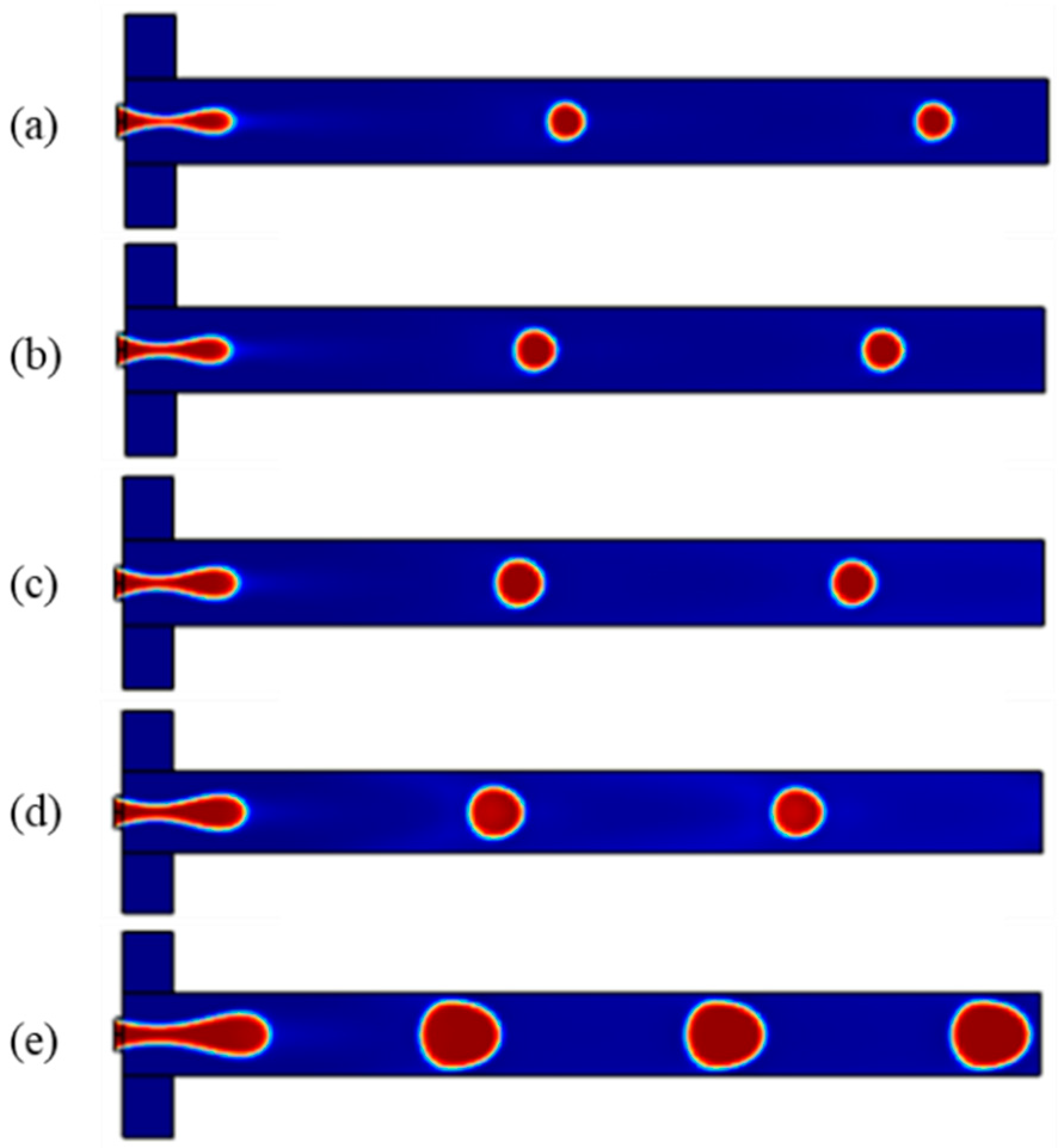
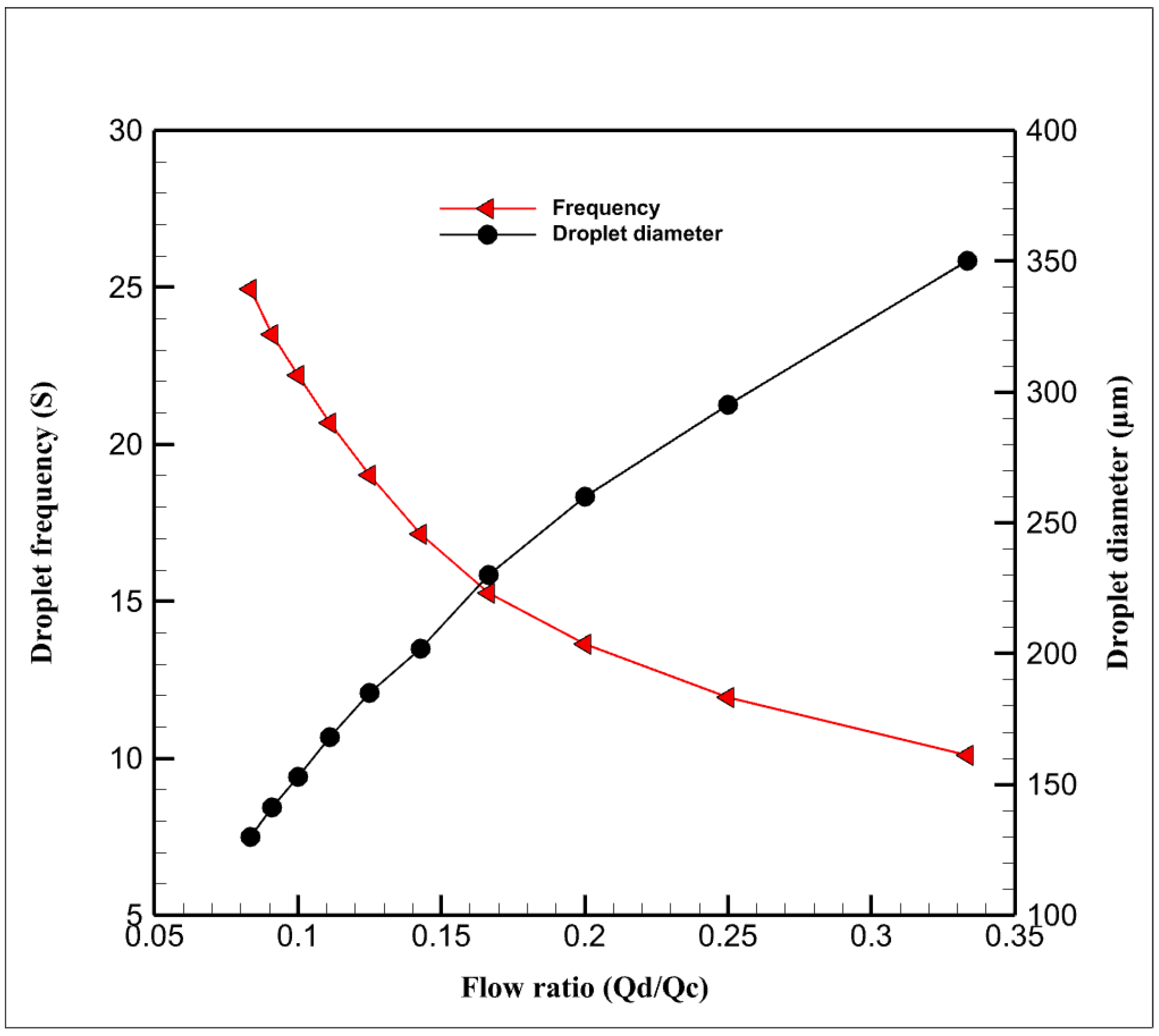

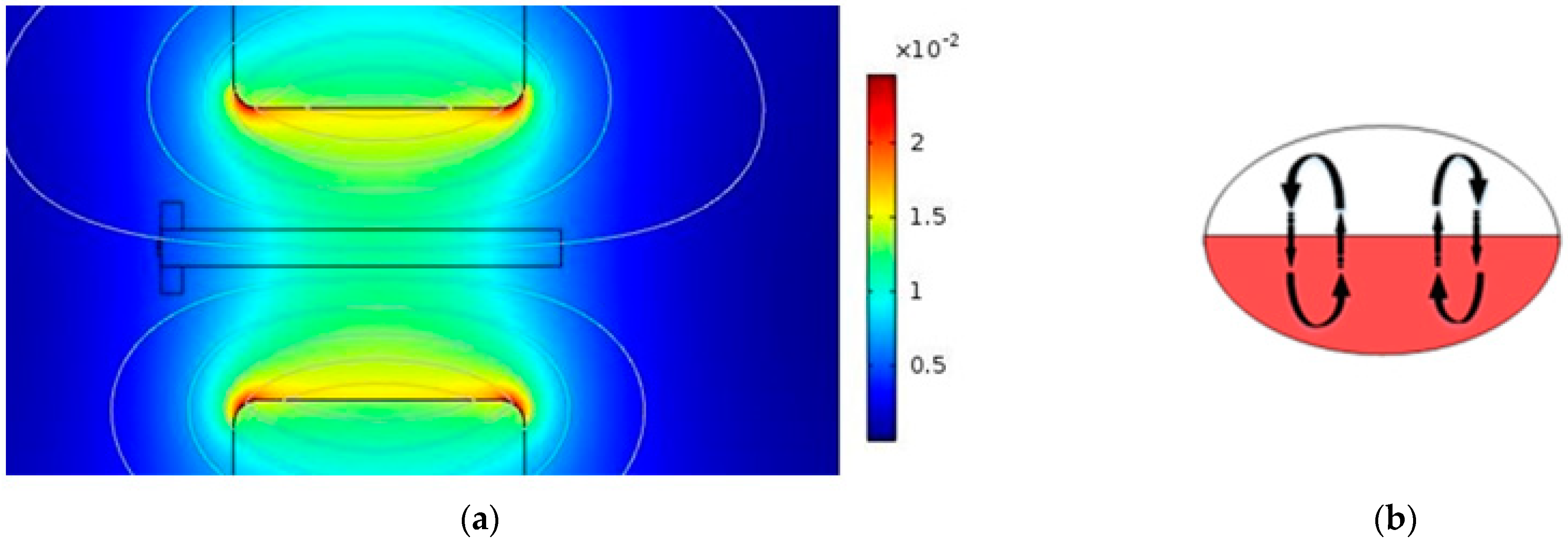
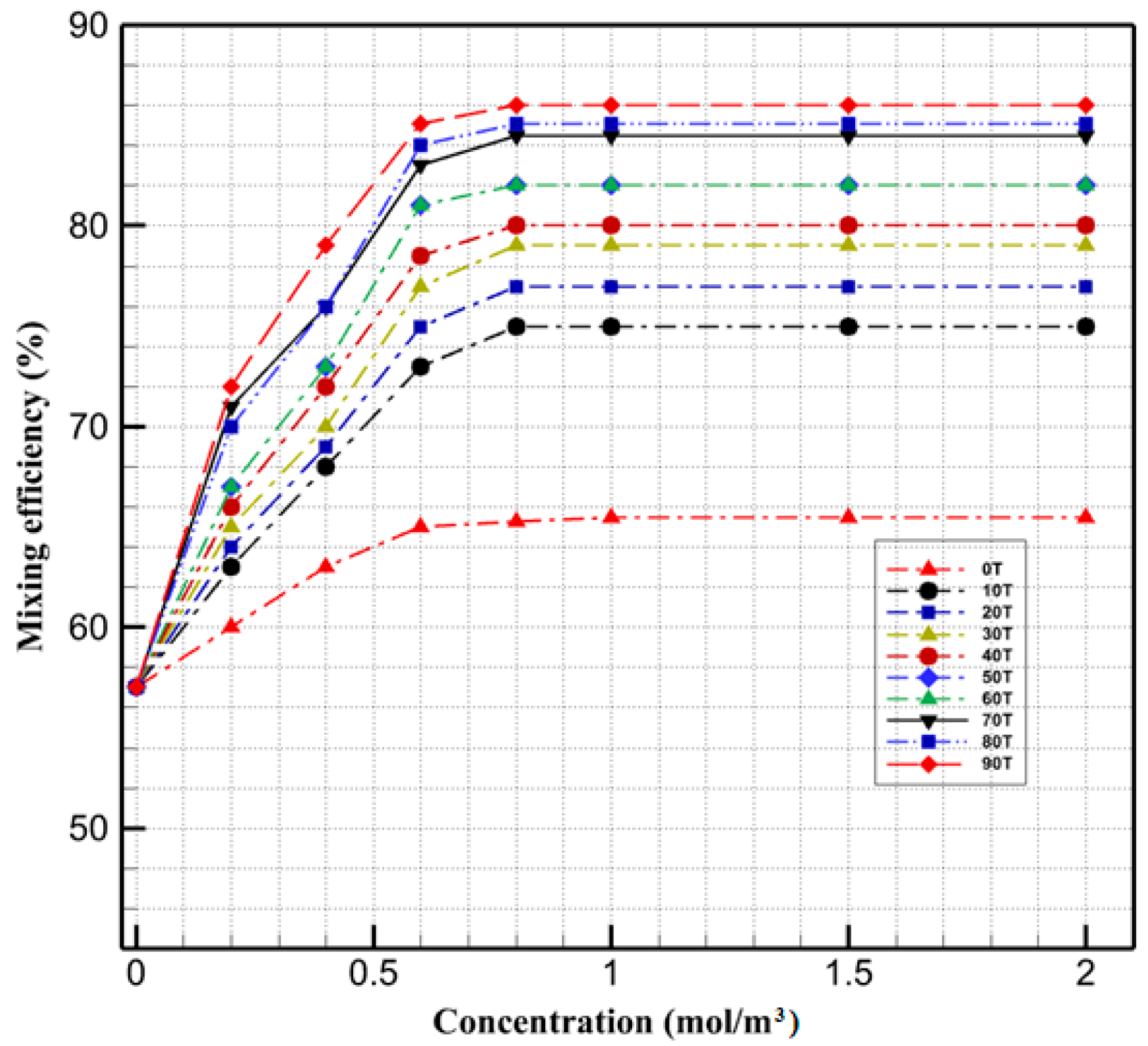
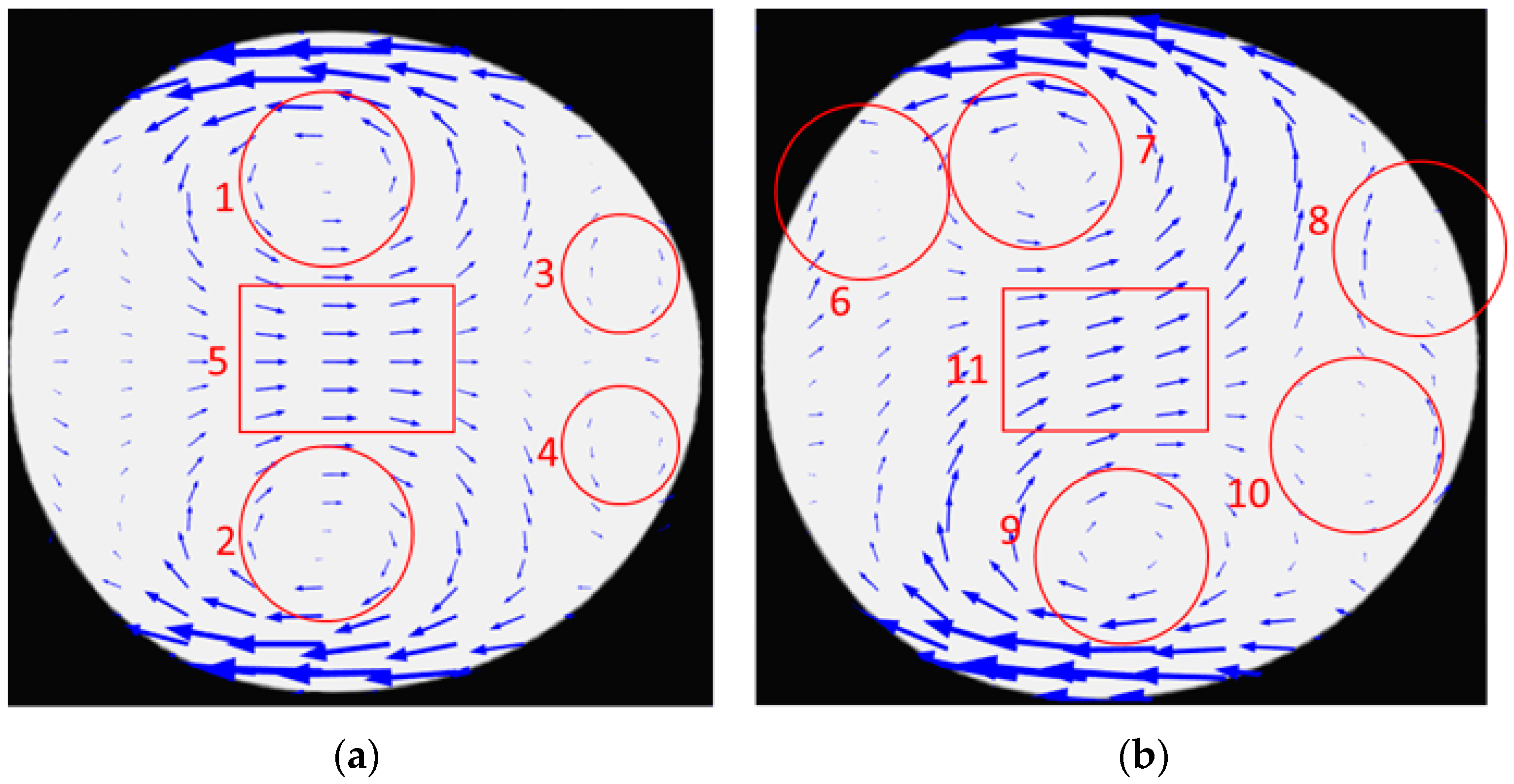
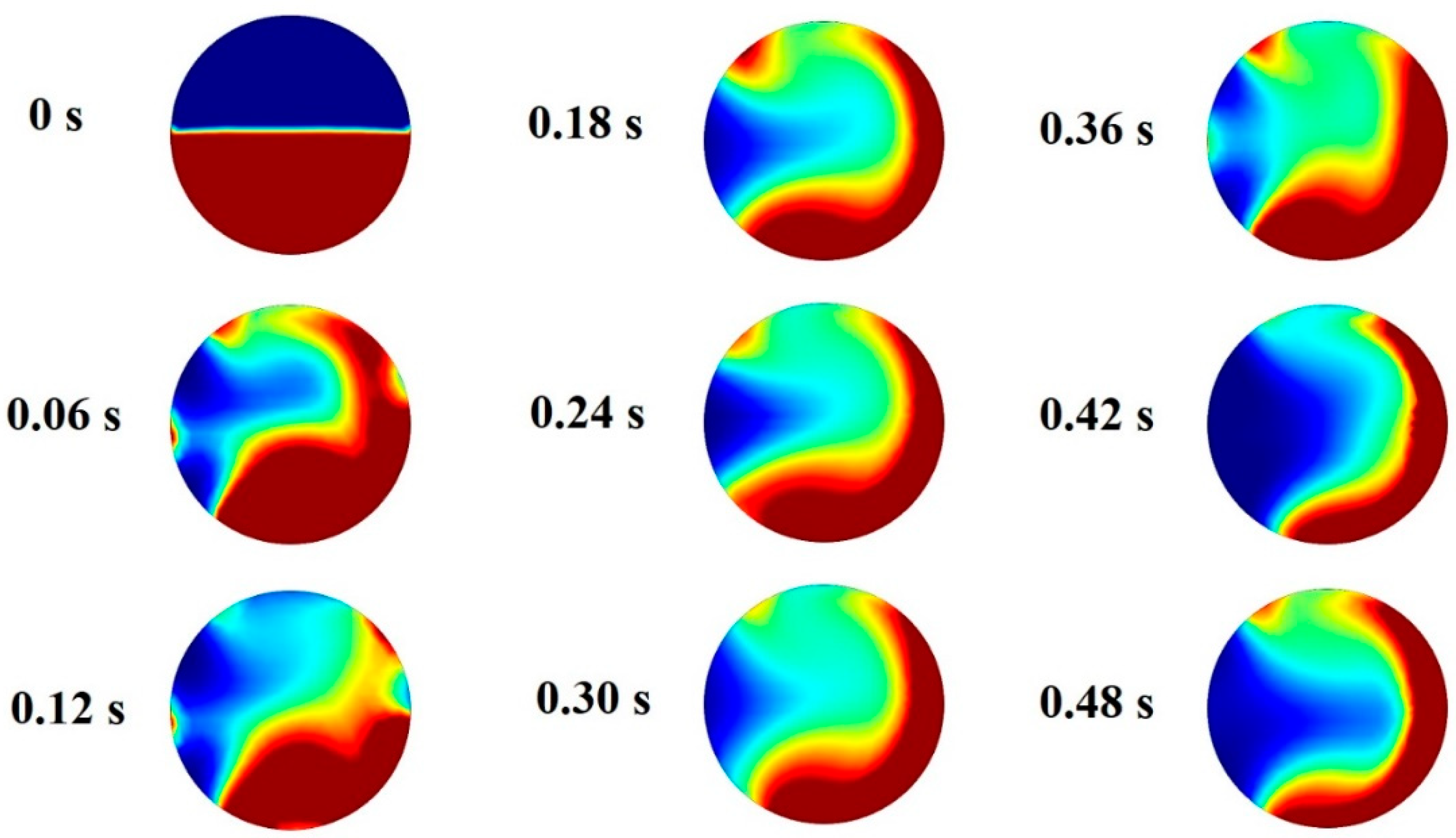
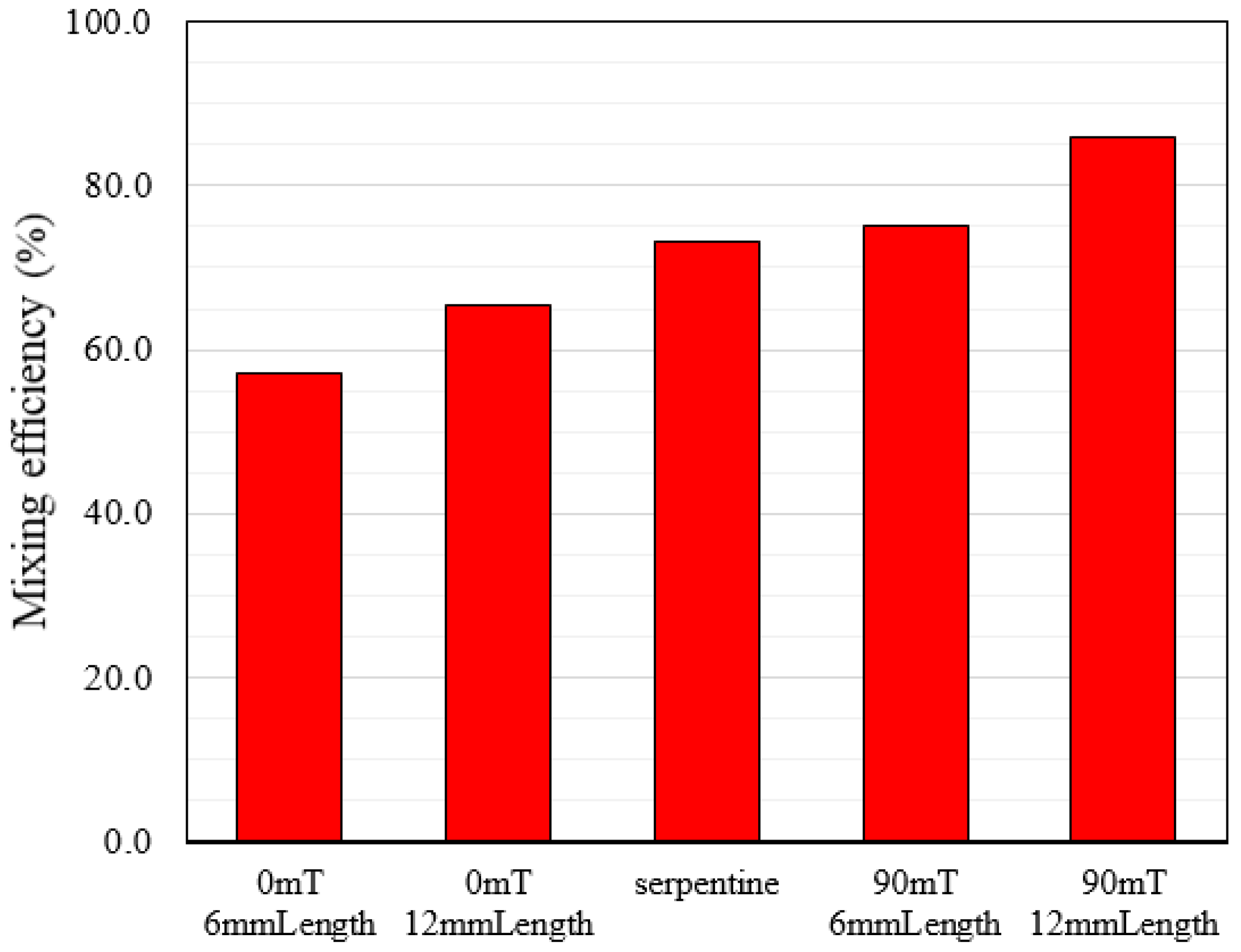

| Results | Droplet Size (µm) | Mixing Efficiency |
|---|---|---|
| Our simulation | 208 | 46.1% |
| Bai et al. [41] | 240 | 47% |
| Error | 13.3% | 1.9% |
Publisher’s Note: MDPI stays neutral with regard to jurisdictional claims in published maps and institutional affiliations. |
© 2022 by the authors. Licensee MDPI, Basel, Switzerland. This article is an open access article distributed under the terms and conditions of the Creative Commons Attribution (CC BY) license (https://creativecommons.org/licenses/by/4.0/).
Share and Cite
Rezaeian, M.; Nouri, M.; Hassani-Gangaraj, M.; Shamloo, A.; Nasiri, R. The Effect of Non-Uniform Magnetic Field on the Efficiency of Mixing in Droplet-Based Microfluidics: A Numerical Investigation. Micromachines 2022, 13, 1661. https://doi.org/10.3390/mi13101661
Rezaeian M, Nouri M, Hassani-Gangaraj M, Shamloo A, Nasiri R. The Effect of Non-Uniform Magnetic Field on the Efficiency of Mixing in Droplet-Based Microfluidics: A Numerical Investigation. Micromachines. 2022; 13(10):1661. https://doi.org/10.3390/mi13101661
Chicago/Turabian StyleRezaeian, Masoud, Moein Nouri, Mojtaba Hassani-Gangaraj, Amir Shamloo, and Rohollah Nasiri. 2022. "The Effect of Non-Uniform Magnetic Field on the Efficiency of Mixing in Droplet-Based Microfluidics: A Numerical Investigation" Micromachines 13, no. 10: 1661. https://doi.org/10.3390/mi13101661
APA StyleRezaeian, M., Nouri, M., Hassani-Gangaraj, M., Shamloo, A., & Nasiri, R. (2022). The Effect of Non-Uniform Magnetic Field on the Efficiency of Mixing in Droplet-Based Microfluidics: A Numerical Investigation. Micromachines, 13(10), 1661. https://doi.org/10.3390/mi13101661








